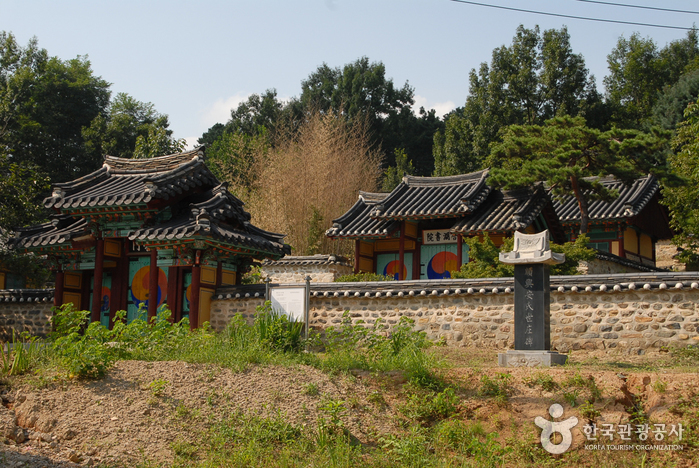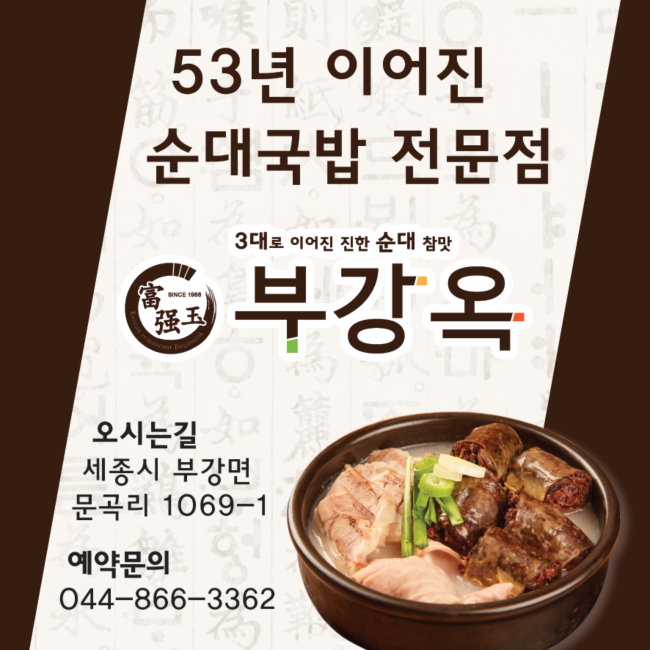Ecole confucianiste Haposeowon (합호서원)
18.7 Km 4892 2022-09-07
262-6, Wonhapgang 1-gil, Yeondong-myeon, Sejong-si
+82-44-330-5832
Enregistré comme patrimoine culturel matériel de Corée, l'académie confucéenne Haposeowon est l'endroit de conservation des tablettes de An Hyang, un érudit réputé durant la période Goryeo. L'académie a été fondée en 1716 par les descendants de l'érudit avant la fermeture des instituts du genre durant la seconde partie de la dynastie Joseon. En 1949, l'académie Haposeowon a été reconstruite avec le soutien de différentes écoles confucéennes à travers le monde.
Mok hyang jae[Korea Quality] / 목향재 [한국관광 품질인증]
18.9 Km 321 2020-12-04
33, Mannam-ro 6-gil, Sejong-si
+82-10-8666-1217
Mokhyangjae, which literally means a ’house with tree fragrance,’ is a traditional Korean pension house which stands alone beside a boulevard surrounded by apartment complexes. Entering the garden with a low fence, you will be greeted by the antique two-story Korean style building. The building of Mokhyangjae was built in the style of a palace with red pine tree used for the crossbeam and pillars. With a feeling of magnificence and coziness at the same time, the rafter ceiling shows the wood grain and the sliding door pasted with traditional Korean paper adds to the flavor of the traditional Korean style house.
The rooms are composed of the traditional Ondol Room where one or two persons can stay; the Ordinary Room is equipped with a bedroom and an attic; and the Deluxe Room has a wide traditional Ondol room for guests from solo travelers to families. The bedroom and the living room also have traditional display cupboard and heavy hardwood table which had been used by the owner of the house, adding to the flavor of the traditional Korean style house. Equipped with cartoons and picture books, the attic is a favorite place of children. Scattered with stepping stones, the front yard of the house is filled with Sansuyu, magnolia, and cherry trees that blossom in spring.
Mokhyangjae is running a traditional teahouse as well. The teahouse was opened thanks to the Chinese husband who enjoys tea, and most of the teas are imported from China. You can have a taste of dozens of kinds of teas including puer tea and red tea, along with a simple tea confectionery.
Temple Hwangnyongsa à Sejong (황룡사(세종))
18.9 Km 9365 2021-04-02
22-17, Hwangujae-gil, Yeondong-myeon, Sejong-si
+82-44-864-7000
Le temple Hwangnyongsa est rattaché à l’ordre du bouddhisme Taegojong. Aucune information n’est disponible sur la date de construction du temple, mais il est dit que ce dernier fut fondé par les descendants de Hwang Hee (1363-1462).
Cet homme retourna dans sa ville d’origine pour éviter un conflit politique durant le milieu de l’ère Joseon, souhaitant le maintien de la paix et la prospérité du clan de famille. Le temple fut donc entretenu pendant des générations par la descendance de Hwang Hee, mais s'est retrouvé en ruine avec le temps. Il fut rénové plus récemment.
Les bâtisses actuelles furent recontruites par le moine Beobin en 1985. Dans l’enceinte, on trouve les bâtisses boudhistes Daeungjeon, Gwaneumjeon, Samseonggak et Beomjongnu. Les bâtiments
additionnels incluent une pagode à 3 étages et des statues de Bouddha en face du hall Daeungjeon. La statue du Bouddha debout Gwanseeumbosal représente la plus vieille relique du temple. Elle est âgée d’environ cent ans.
Bugangok (부강옥)
19.3 Km 24 2021-03-24
103, Bugangoecheon-ro, Sejong-si
+82-10-9577-8953
It is a restaurant that’s featured a lot in various media. This Korean restaurant is located in Sejong-si. The representative menu is blood sausage and rice soup.
Baek il heon Head House [Korea Quality] / 논산 백일헌 종택 [한국관광 품질인증]
19.4 Km 9208 2020-09-08
45, Jugok-gil, Sangwol-myeon, Nonsan-si, Chungcheongnam-do
+82-41-736-4166 / +82-10-2911-4166
The Baegilheon Head House (National Folklore Cultural Heritage No. 273) is the house that was bestowed upon General Yi Sam by King Yeongjo in recognition of his achievement in suppressing the Yi In-jwa Rebellion in 1728. King Yeongjo also granted Yi Sam the posthumous name ‘Baegilheon’. The house is composed of the munganchae (gate quarters) situated next to a tall gate, the ‘ㄷ’-shaped anchae (women’s quarters), and the ‘ㄱ’-shaped sarangchae (men’s quarters), which are configured in an overall square layout. The accommodation includes the munganchae, the araet sarang with a numaru (upper floor), and the wit sarang and the geonneotbang, each of which has a large toenmaru (a narrow wooden porch running along the outside of the building). Notably, the geonneotbang, which is connected with the daecheong (wooden floor) and has a cozy courtyard surrounded by a mud wall, was the living space for the eldest son of the family and his wife for many generations. As the house has been designated as a National Folklore Cultural Heritage, cooking in the guestrooms is strictly prohibited. However, the house provides breakfast prepared by the daughter-in-law of the head house free of charge. The toilets and shower room are situated in the back yard.
Forêt récréative de Maninsan (만인산 자연휴양림)
19.4 Km 0 2023-01-25
106, Sannae-ro, Dong-gu, Daejeon
La forêt récréative de Maninsan se situe à 17 km de la route nationale 17 depuis la gare de Seodaejeon, à la frontière entre la ville de Daejeon et Geumsan-gun, région Chungcheongnam-do.
Il s'agit d'une forêt récréative proche de la ville où l'eau claire coule dans la vallée et où s'étend une épaisse forêt de feuillus. Sur la crête, la forêt est divisée en une zone de villégiature familiale, une zone pour la jeunesse et une zone de pique-nique, ce qui en fait un agréable lieu de repos pour les citadins. L'aire de repos du mont de Maninsan est une installation construite avec des capitaux privés datant de l'année 1990. Au moment de la construction, la forêt a été préservéealors que la vallée naturelle a été utilisée telle quelle pour créer une installation technologique dans la vallée répartie sur 2 étages au-dessus du sol et 1 étage en sous-sol.
Devant l'aire de service, un étang a également été créé pour s'harmoniser avec le paysage naturel. Il s'agit d'une des plus belles aires de repos en Corée. C'est aussi le lieu de prédilection des citadins pour passer leur temps libre. Parmi les installations sur place, le pavillon Maninrugak constitue un bâtiment de loisirs célèbre sur le mont Maninsan. Bâtiment emblématique de Rujeong, ce pavillon adopte le style architectural de Segeomjeong au pied du mont Bugaksan à Séoul. Ce pavillon est un témoin de la beauté du style architectural traditionnel coréen.
Terminal des bus interurbains d'Okcheon
19.9 Km 2975 2016-07-08
232-20 Samnyang-ri Okcheon-eup Okcheon-gun Chungcheongbuk-do



![Baek il heon Head House [Korea Quality] / 논산 백일헌 종택 [한국관광 품질인증]](http://tong.visitkorea.or.kr/cms/resource/98/2530098_image2_1.jpg)

 Français
Français
 한국어
한국어 English
English 日本語
日本語 中文(简体)
中文(简体) Deutsch
Deutsch Español
Español Русский
Русский